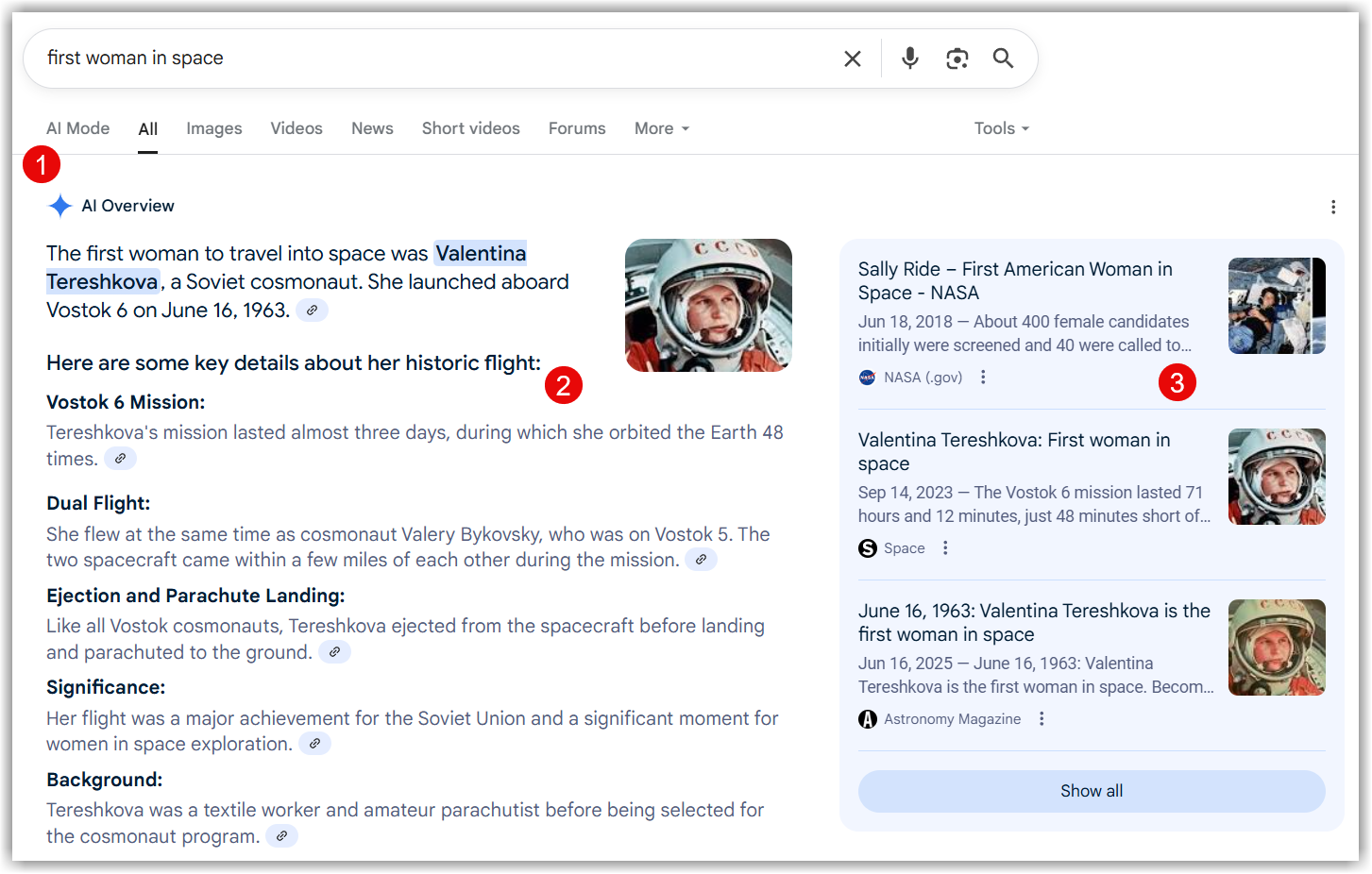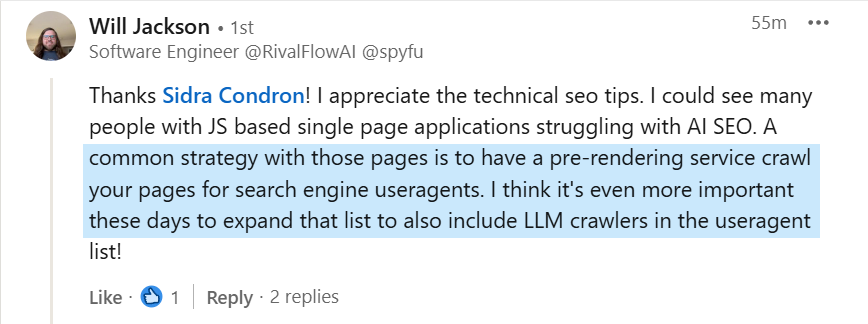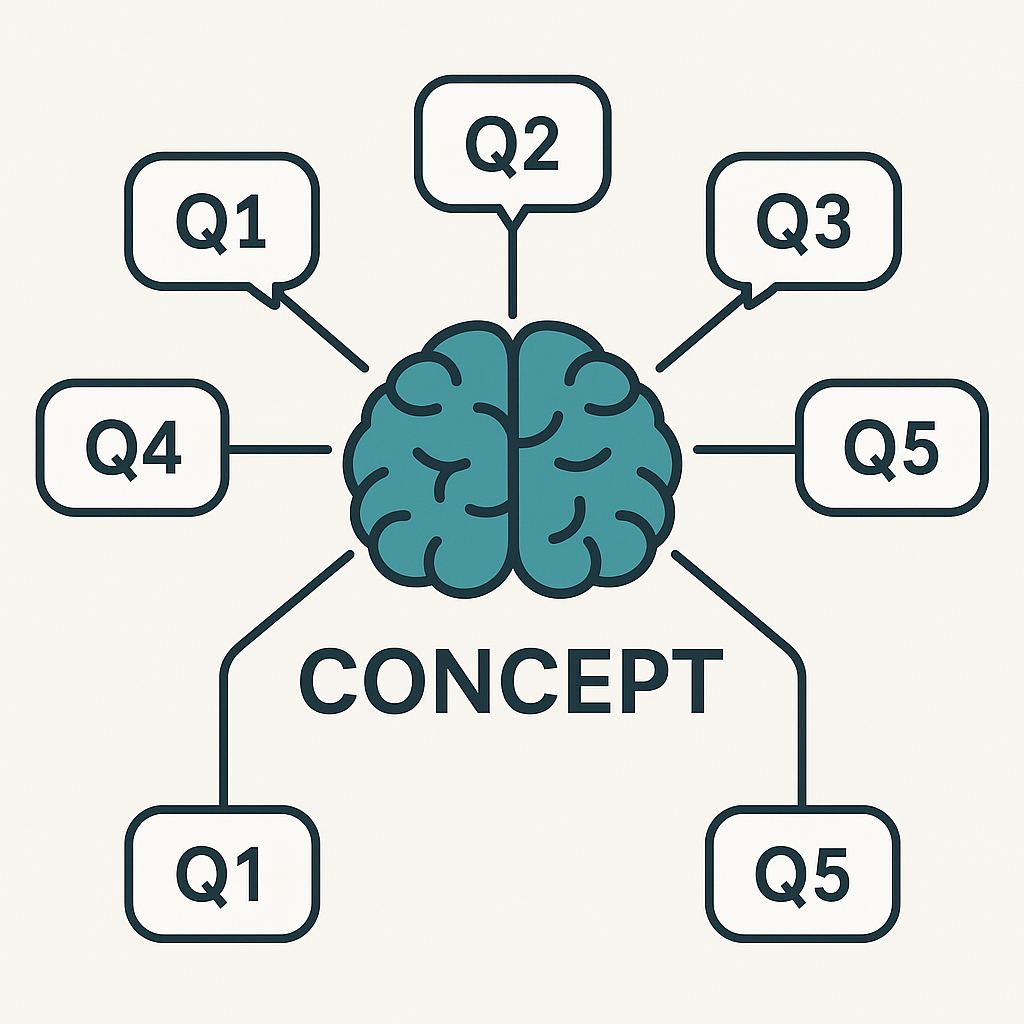Now that search engines are leading with AI Overviews and AI assistants are getting answers for us, SEOs are adapting to the shift. After all, you still want your content to be found first. Fortunately, the core of AI SEO best practices stem from much of what you've already been doing.
If you’re writing helpful content that answers real questions, congratulations; you’re 80% of the way to AI success. In fact, many of your ongoing SEO-driving habits are working double. I've included an "Already Doing This?" segment at the end of each point. I loved learning that I was on the right track and wanted to do the same for you. But don't let off the gas--AI SEO/GEO is new, and we're all learning to adapt.
*Heck yes I'm going meta.
Featured snippets were the first wave of clickless SERPs. Direct questions like "Who was the first woman in space?" would have gotten the answer "Valentina Tereshkova" right on the page with no need to click for the answer.
Now, think of Google's AI Overviews as featured snippets 2.0: they stitch together multiple sources, cite them inline, and answer follow-up questions in-context. It makes room for more complex answers, or it offers extended answers like explaining that Sally Ride was the first American woman in space.

I can't help but think of Old Macdonald's Farm when I see the AI SEO/GEO/AIO lineup. AI SEO is a general term for optimizing content for use in LLM platforms. Since those models fuel Generative AI platforms, we also see phrases like GEO (generative engine optimization) and AIO (AI optimization) in play.
However, AIO is also shorthand for search engine AI Overviews, not to mention "all in one." Two strikes for AIO. GEO has location-based connections like geo-fencing and geo-targeting. Earlier today, our Google Ads Manager, Tree, told us that he can't advertise on "GEO", because it's not a reliable keyword to bid on yet (but "generative engine optimization" is fine).
As expected, there's noisy debate over which terms we should adopt, and I have to admit it's exciting to be at the beginning of this.
In this guide, I'll mostly be using AI SEO to talk about updating your content so that it's cited in AI platforms, and I'll use SEO for its most recognizable use in optimizing your content for search engine results.
All of that housekeeping out of the way, here's how to optimize your content for AI. It starts with today's strongest, foolproof, guiding principle.
Great AI SEO begins with the core guidelines of strong SEO—share helpful, original answers that reflect expertise and real-world experience.
Firsthand insight is what sets one resource apart from another. LLMs and search engines alike value it, and readers clamor for that spark that tells them they're getting real-world experience. LLMs look for signs of human-driven expertise like opinions, proprietary data, detailed walkthroughs, and quotable expert commentary. That gives AI "confidence" to cite you.
Open with a strong answer up front: Start every article with a crisp, 45-to-65-word paragraph that answers the key question. In past articles, I've used summary tables or jump links instead of slowly teasing and stretching out the answers.
Sprinkle proof of actual people in your content: Use photos of your products, offer real-world examples and mini case studies. If you offer services over products (like lawyers and marketing agencies), talk about actual issues you've helped clients work through and how others can learn from it.
Attribute insight to real humans: Author bio pages are a good start, but don't overlook opinions and pro tips that you and your team uniquely offer. We're fans of local businesses writing ultra-specific tips. Appliance repairmen see enough refrigerator ice makers fail during hot summers to let customers know that they're not the only ones. That experience--along with prevention tips--might pop up when a homeowner searches their problem.
AI engines don’t ingest entire pages at once; they grab bite-sized passages and weigh them for relevance. Fill your page with tightly focused sections (concise answer with minimal fluff) that make it more likely to be cited. Think of every sub-section as its own self-contained “answer capsule” ready to be quoted in an AI Overview.
Create concise answers that are overview-ready. Format your explanations as numbered steps or tight summaries.
Make your H-tags conversational: Mirror the language that your customers speak and would ask in that moment. LLMs rely on semantic similarity, not just keywords.
Predict and prepare citation-ready chunks: Break long walls of text into lists, tables, or FAQs. Plus, a short format forces you to focus on substance over fluff.
Structured data acts like a shortcut for LLMs to understand the key focus on your specialized content. Hyper-specificity seems to be where AI answers shine, so adding context to your page can only help tie your content to the right questions.
Use a few of these schemas as a starting point or inspiration of how to optimize your page one step further.
These actions should help your page appear as more than standard blue link results. But to be sure, you can validate them via Google’s Rich-Results page.
Slow, hidden, or duplicate pages break AIO visibility even if the content itself is solid. Since many technical issues can remain hidden until we dig for them, treat these tasks as preventative measures. It could save you some headaches down the road.
Aim for real-time indexing: Submit updated XML sitemaps and use IndexNow for Bing crawls.
Be mindful of render limitations: If your main content is displayed via JavaScript, it's not a problem for people, but bots can't access it without help. You can keep the core article text in HTML , or lean on server-side rendering.
Serve lean, fast pages: We saw low scores in our Core Web Vitals and found that every blog page's featured image was slowing down load times. Resizing those images was enough to move the needle.
Keep canonical pages and robots info up to date: Avoid noindex on pages you want AI to surface. Oh, and here's where we had hidden challenges sneak up on us--test environments and variant URLs can pop up and cause issues. Keep them in check.
✔️ Update: After I shared this article on LinkedIn, one of our Developers dropped in with some valuable insights on JS based pages. (That last bullet item is proving true!) Short answer: a prerendering service can help.

Our Social Media Manager Amanda added context that paints the importance of this:
For anyone else who isn’t a dev (like me!), this is the kind of thing that can sneak up on you if your site uses a lot of JavaScript... Basically, your content might not even get seen by AI tools unless you’ve set things up for them to read it. Great reminder that it’s not just about writing great content, it also has to be findable!
Here's how Will elaborated:
We've had some great success with Prerender.io®. They recently touched on advice on how to allow LLM crawlers to see the pre-rendered pages. It shows they are committed to the changing landscape and empowering their users to adapt.
It can be something super easy to overlook on SEO teams since the major search engines have all been around so long. But definitely worth the small time investment to make sure LLMs can surface your content.
(Content is a team effort, y'all.) -- Sidra
Take the E-E-A-T principle of "authority" and imagine how far that can reach online. There's your AI playground. LLMs are pulling in references from other sites to assess whether your brand is worth boosting. Keep tabs on how your brand is "seen" via trusted, 3rd party platforms.
Brand mentions, not just backlinks We've gotten used to this idea of authority via backlinks, but LLMs are weighing frequency and context of mentions across Reddit, reviews, and forums. Encourage reviews on G2 and Trustpilot. Remember transcripts from YouTube, podcasts, etc.
Thought-leader footprints Reach out to write guest posts, post presentation decks, and make your original research shareable.
Consistency in branded products Use the same brand/product phrasing everywhere so AI can map variants back to you. Having your brand consistent might be obvious, but do you refer to your products with enough consistency and familiarity that others are using the right phrasing too?
Think beyond text-focused pages and HTML. Every indexable file is another opportunity to get new eyes on your content.
Publish Videos with transcripts: YouTube creates auto-captions and transcripts, and you can edit them via YouTube Studio's subtitles options. We also love (and use) Descript for social media reels. Its custom word list helps with credibility when using industry jargon.
Elaborate with Slides and PDFs: That thought leadership we mentioned in the previous section works well in SlideShare, Google Drive embeds, or downloadable guides.
Share your code snippets as GitHub Gists: Code and API examples make for great content. Grow its discoverability by publishing it as a public Gist and embed it on your page for users. That gives search engines and LLMs a trusted source to crawl and cite.
These search-based tools seem to lead to even more follow-up questions. Be ready to deliver. Include sections that dive deeper (e.g., pros & cons, pricing nuances, troubleshooting). That keeps you in the conversation and reduces the risk of users bouncing to another source.
Create a detail-loaded section: Use expandable FAQs under each section to answer related questions without ballooning the main body.
Research keyword topic clusters and put them into action: Make this prep work part of your content process so that your page covers expanded topics naturally. Link to other pages where you've gone more in-depth on related issues.
Get ahead of questions people ask. Chase questions specifically. Imagine what people would want to know, and address it clearly. Look at Google's "Questions people ask" for inspiration. That's just the start. Serve up concise answers that LLMs can pull into summaries.
We touch on that ahead, looking at how RivalFlow has already been predicting and aiming for the answers that people want to find.
As with SEO, these are sound practices that deliver different levels of success. It's important to iterate on them, but first you need to measure results objectively.
Add UTMs to key internal links: Be specific with the UTM parameters that you can control, and watch for these referrers in your analytics.
ref=ai_overview
chat.openai.com
copilot.microsoft.com
perplexity.ai/referral
Run quarterly AI audits: Manually run your top queries in major tools, screenshot results, and log bad answers.
Prepare for changes in Google Search Console: Impressions and clicks used to rise and fall together, but serving answers in AI overviews gives you greater impressions and fewer clicks. Expect to see a significant gap between the two metrics.
When we created RivalFlow, we didn't realize that we were engineering it to optimize for LLMs too.
Search engines used to surface results based on a keyword-index foundation. If you searched “car maintenance tips on a budget,” the engine fetched pages that literally contained those tokens, then used other factors to determine which pages were sorted first.
Large Language Models (the tech behind AI Overviews) start with vectors—they look for ideas rather than specific words (car, auto, and vehicle are all tied together). They're looking for the best conceptual matches, so the user's phrasing is not as important as the answer they hope to find.
"To make RivalFlow effective, we had to look at a page in terms of concepts rather than a bucket of keywords."

Ultimately RivalFlow asks "What are the questions that we would want answered on this topic?" And then we put those things into our content.
It has been using the same "fan out" approach that AI platforms do. Let's keep the car example going. When a user searches "hidden costs in electric cars," LLM-powered engines "fan out" (kind of like autocomplete) to come up with variations of narrow questions that night help get to that answer.
These micro-queries run in parallel. The best passages that match them are stitched together and paraphrased into one natural sounding overview.
Pages that pre-answer those micro-questions win more citations.
If your article offers clear H2s and concise answer "chunks" for each likely sub-question, the engine lands on your page while it's assembling its summary and continues to satisfy its task. While it's still too early to guarantee anything, that can only set you up for multiple citations, bigger on-screen real estate, and steady referral traffic from the AI answer box.
RivalFlow looks for missing micro-questions.
The tool follows a similar fan-out method alongside questions that competitor pages answer. After a short analysis, it lists the most important relevant sub-questions that users would want to know (and that search engines would chase).
A lightning-fast fix, written to blend in with your existing text.
For each gap it suggests a headline and a tight, people-first answer paragraph — so you patch the hole in minutes, not hours.
Fan-out questions are a safety net for searchers.
I like this idea: Fan-out queries are just the engine’s way of double-checking that it can give users a fully fleshed answer. RivalFlow is making sure that those answers live on your page, giving you built-in optimization for today’s SEO and tomorrow’s LLM-driven search.
For any content gaps that it finds (missing questions) RivalFlow suggests concise answers to pepper into your written content.
By adding detail, examples, and deeper information to your page, you're expanding the perspective on a topic. That improves your substance and aligns with a concept-focused world. This keeps both classic SEO and AI Overviews happy.
RivalFlow's aim is to expand your page with helpful, thorough details that you hadn't covered before. The end results should be good SEO signals that serve AI SEO too. Long term, AI SEO is about finding the best answers for what the customer wants to find. We're doubling down on efforts to keep you on the right track.